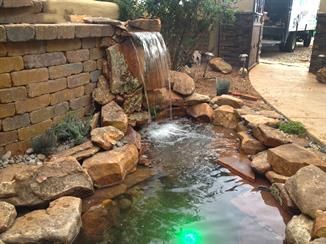Fort Wayne (260) 247-9742
Carmel Indiana (463) 270-0414
Could Your Outdoor Water Feature Be Helping The Environment?


Backyard water features, such as ponds, fountains, and waterfalls, are popular landscaping elements that add beauty and relaxing vibes to your outdoor living space. In addition to their aesthetic value, did you know that backyard water features can also offer several environmental benefits? Let’s take a look at how exactly that works!

What kind of critters do you have in your backyard? Just as we enjoy relaxing by a pond, fountain, or waterfall, so does the local wildlife. These features can provide a welcoming habitat and food sources for various species. Ponds, in particular, can support a diverse array of flora and fauna, including fish, frogs, turtles, dragonflies, and water plants. The presence of water in residential landscapes can attract and support wildlife that may not have suitable habitat in other areas, especially in urban or suburban environments where natural habitats are often fragmented or lost. Backyard water features can serve as important stepping stones for wildlife movement and gene flow, promoting biodiversity conservation in local ecosystems.


What else can they do? Backyard water features can also improve water quality. When designed and maintained properly, these features can act as natural filters, helping to purify rainwater runoff and prevent pollution from entering local water bodies. The water in backyard features goes through a process of natural filtration, where debris and excess nutrients are removed by aquatic plants and beneficial microorganisms. This can reduce the amount of sediment, nutrients, and pollutants that would otherwise enter stormwater runoff and eventually end up in rivers, lakes, and oceans. Backyard water features can, therefore, contribute to mitigating water pollution and improving overall water quality in the surrounding environment.


What else can they do? Backyard water features can also improve water quality. When designed and maintained properly, these features can act as natural filters, helping to purify rainwater runoff and prevent pollution from entering local water bodies. The water in backyard features goes through a process of natural filtration, where debris and excess nutrients are removed by aquatic plants and beneficial microorganisms. This can reduce the amount of sediment, nutrients, and pollutants that would otherwise enter stormwater runoff and eventually end up in rivers, lakes, and oceans. Backyard water features can, therefore, contribute to mitigating water pollution and improving overall water quality in the surrounding environment.

Although water scarcity isn't usually a significant problem in the Midwest, water conservation is a critical aspect of sustainable landscaping practices. Your backyard water feature can play a role in water conservation efforts. For example, ponds and other water features can act as rainwater harvesting systems, collecting, filtering, and storing rainwater that can be used for irrigation. This can reduce the reliance on potable water for landscaping purposes, leading to water savings and promoting sustainable water management practices. Additionally, properly designed backyard water features can also help reduce water loss through evaporation by providing shade and reducing the exposed surface area of water, especially during hot and dry periods.
BROWSE OUR WEBSITE
CONTACT INFORMATION
Fort Wayne: (260) 247-9742
Carmel Indiana: (463) 270-0414
Email: totalhomeandtech@gmail.com
Address: 3212 Mallard Cove Lane Suite CFort Wayne, Indiana 46804
Trade ID: 313172





BUSINESS HOURS
- Monday
- -
- Tuesday
- -
- Wednesday
- -
- Thursday
- -
- Friday
- -
- Saturday
- Closed
- Sunday
- Closed
